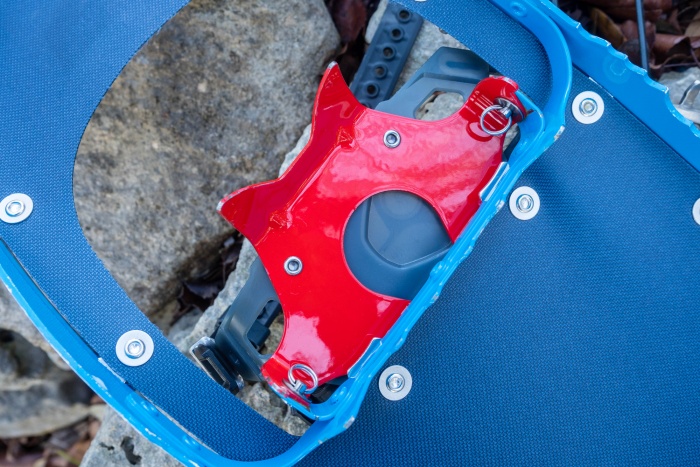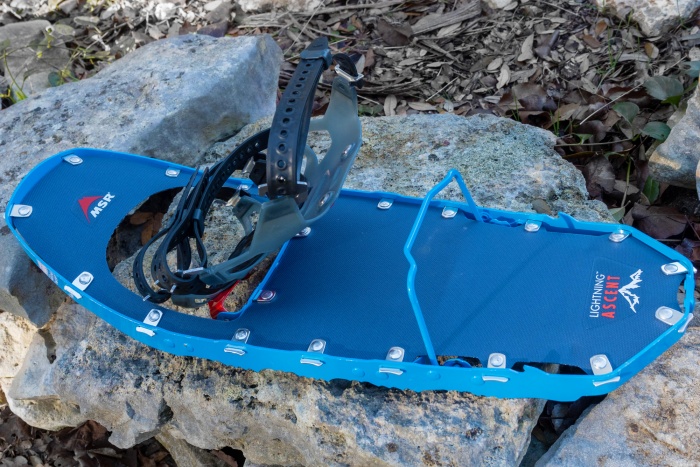MSR retooled its iconic Lightning Ascent, a highly regarded mountaineering snowshoe, to perform better and improve durability. So we tried out a pair in mountain terrain to see for ourselves.
MSR knows snowshoes. It began producing its first iterations in 1995, and its designs have always been unique. In 2004, the brand introduced the mountaineering-focused Lightning Ascent line; its toothy aluminum exoskeleton and steel cross members provided exceptional traction in challenging alpine terrain.
These were the first snowshoes with heel lifts, and they incorporated MSR’s unique modular tails to increase flotation when needed.
The most recent update to the MSR Lightning Ascent released in September 2017. The $300 pair specifically addressed one common complaint: The crampon teeth could bend during use in icy conditions. The brand also claimed improved durability in the frame. I tested a pair during a three-day avalanche safety and rescue course in the North Cascades hosted by Mountain Bureau LLC.
In short: MSR’s updated Lightning Ascent – in men’s and women’s – improve on already impressive snowshoes. The traction, durability, performance, and light weight have made them favorites for those traveling in steep and technical alpine environments. And the improved strength only adds to the desirability of these snowshoes.
MSR Lightning Ascent Traction
A standout characteristic of the MSR Lightning Ascent is the fantastic traction. The entire “360° Traction” 7075-T6 aluminum frame, thicker than previous models, provides edges along its entire circumference and is serrated.
Plus, there are two serrated aluminum cross members, and the hinged crampon has two separate sets of teeth. All these features combine to create traction unrivaled by tubular-framed snowshoes. MSR constructs the new “DTX” crampon out of a thicker, continuous piece of martensite steel with altered tooth geometry. This noticeably improves bending resistance on ice.
I experienced excellent traction during the avalanche safety class. Steep climbs and sidehills on consolidated snow, descents on loosely packed snow, and even icy parking lots – I navigated it all with confidence and never felt traction concerns. Both frame and crampon teeth suffered no structural damage, even after crossing and walking down many rocky creek beds.
Lightning Ascent Snowshoe Flotation
I tested the 22-inch version of the Lightning Ascent (also available in 25- and 30-inch versions) and found the flotation and the urethane-impregnated nylon decking to be exceptional.
I weigh 165 pounds and was carrying about 15 pounds on my back. During testing, I stayed at the top or just below the snow surface except in loosely packed, deep new snowfall and snow softened by rain and higher temperatures. Optional 5-inch-long tails ($60) can add additional flotation.
Ergonomics
I found the freeze-proof “PosiLock AT” binding’s 3-foot straps and single heel strap easy to operate, even with gloves on. And the highly elastic straps and buckle design resisted ice and snow buildup.
The straps are very long, which offered plenty of adjustment room but necessitated tucking in excess. Boots remained securely planted; the only time I rotated my boot in the binding was when attempting to climb very steep sidehills that were too firm to form an uphill shelf.
I welcomed the “Ergo Televators” heel lifts when the track steepened, and I liked that they are deployable with trekking pole grips. My stride felt natural, no forced adjustments were necessary, and I found the hinged crampon design efficient with the ball of my foot directly over the rotation axis.
The tail length provided no problems on steep descents (I was on the shortest available model), and I felt no need to adjust foot plant to accommodate the width of the snowshoes. The bindings also laid flat when not in use, which allowed the snowshoes to stack flat, making for easy packing and storage.
Although strap hinge systems provide a softer ride, I preferred the solid hinge of the MSR Lightning Ascent. I felt more directly connected to the contact patch on the terrain, and the solid hinge mechanism aided with precise snowshoe placements and loading. These attributes helped deliver more confidence when things got tricky.
MSR Lightning Ascent Snowshoe Review
MSR Lightning Ascent are light; 4 pounds 1 ounce for the pair of 22-inch snowshoes. This stat provided a low swing weight, which added positively to the stride characteristics and made for efficient long-range travel.
The updated Ascent is an excellent choice for snowshoeing in more technical alpine environments. The traction, flotation, and ergonomics allow efficient travel in challenging conditions, and the added durability lends peace of mind for both the adventure and the investment.













